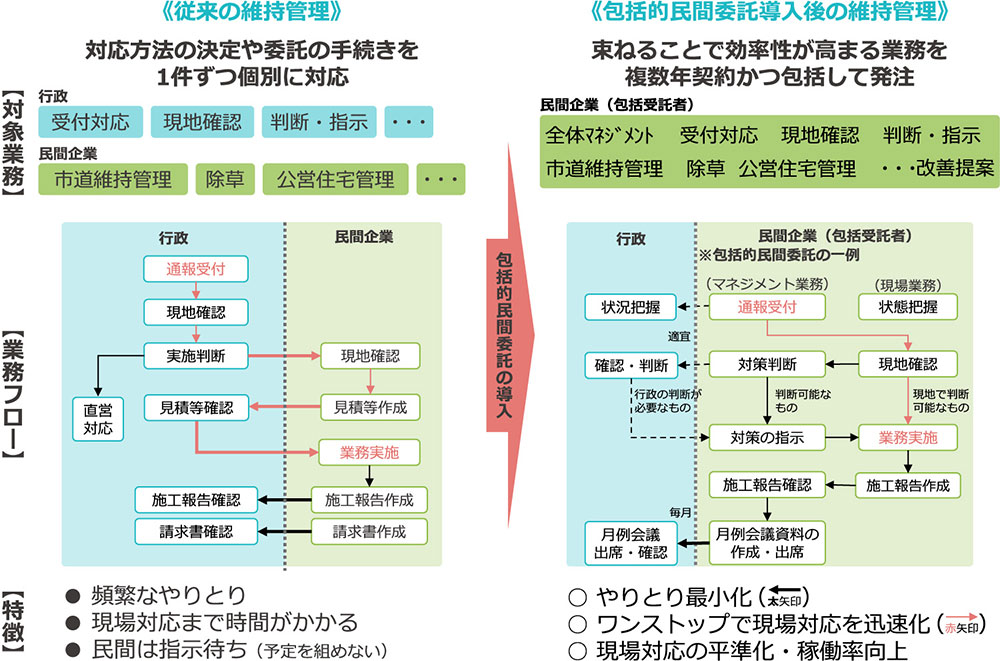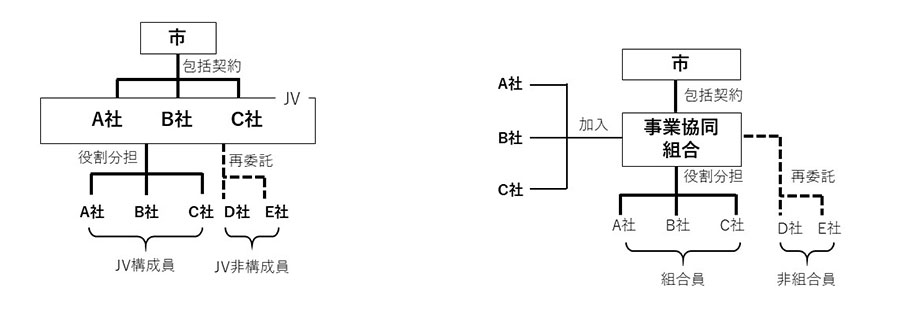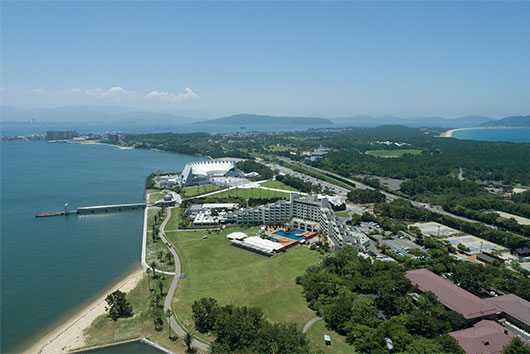How to protect infrastructure such as roads with limited personnel and budgets is a major issue for local governments. One promising method that is garnering attention is "Comprehensive Entrustment to Private Sector." We spoke with three people from PACIFIC CONSULTANTS who have pioneered this field and have achieved many successes: Nobutaka INAMITSU of the Spatial Creation Section, Infrastructure Management Dept., Transportation Infrastructure Div.; Kazuya MURAMATSU of the Infrastructure PPP Section, PPP Management Dept., Social Innovation Div.; and Shigeto TANAKA of the Infrastructure Management Section, Transportation Infrastructure Dept., Osaka Headquarters.
INDEX
- Current Status and Issues of Infrastructure Maintenance Management
- What is Comprehensive Entrustment of Infrastructure Maintenance to a Private Sector? How is it Different from the Designated Manager System?
- Benefits of Comprehensive Entrustment to a Private Sector
- Accelerating Digital Transformation of Infrastructure Maintenance through Comprehensive Entrustment to a Private Sector
- Towards Wide-Area Cooperation with Neighboring Cities, Wards, Towns, and Villages
- The Role of PACIFIC CONSULTANTS
Current Status and Issues of Infrastructure Maintenance Management
Local governments, which have a large amount of infrastructure such as roads, parks, water supply and sewerage systems, waterways, and bridges, are burdened with the increasing maintenance work as the infrastructure aging. Furthermore, the increasing severity and frequency of natural disasters due to climate change increases the risk of disasters, and the need for proper maintenance and renewal of infrastructure from the perspective of disaster prevention is also increasing.
However, local governments are facing tough financial situations and are being forced to cut civil engineering costs. Civil engineering staffs and on-site management staffs have been cut through retirement and non-replacement policies, and local construction companies that actually carry out repair work are also facing serious labor shortages due to the aging of their workforce, resulting in a situation in which there are both budget and manpower shortages for infrastructure maintenance.
As a result, necessary patrols and inspections cannot be carried out as planned, and there are cases where repairs cannot be made immediately even when there are problems with the road, or where sidewalks are left unattended due to overgrown weeds. The current situation is that the road maintenance staffs themselves are forced to go to various sites almost every day to carry out emergency repairs to the pavement. Staffs who would normally draw up maintenance plans, obtain estimates from contractors, and enter into contracts are forced to go out to work on site.
In the first place, the current work of road repairs and other such tasks is very time-consuming. When a defect is identified through patrols or reports from citizens, the staff in charge first makes time to go and see the site. There, he/she decides on a repair policy, returns to the office and request a quotation from the contractor, and the contractor who received the request also goes to the site to check the current situation and prepares a quotation. The staff checks the contents, and after approval within the department, a contract is signed, and then the work is carried out after adjusting the schedule. After the work is completed, the contractor submits a completion report and invoice, and the staff in charge checks the site, checks the contents of the report and invoice, and if there are no problems, they proceed with the payment procedure. Even for a single repair that costs a few hundred thousand yen, so much communication is required, it is not uncommon for it to take several months from the time of the report to the completion of the work. Depending on the size of the municipality, some places perform hundreds of such ordering tasks per year.
Moreover, this back-and-forth process places a heavy burden on the contractor. In the first place, it is unclear when a request for a quotation will come in. However, once a request is received, it is required to respond as quickly as possible. This makes it a "troublesome job" that is difficult to plan and small in scale. Furthermore, it is frustrating for the citizens who use the infrastructure, as they are forced to wait a long time from when they report the problem until the situation is resolved.
The deterioration of social infrastructure, which was built intensively during the postwar economic growth period, will progress rapidly and simultaneously in the future. If things continue as they are, local governments, construction companies, and citizens will inevitably become increasingly dissatisfied.
What is Comprehensive Entrustment of Infrastructure Maintenance to a Private Sector? How is it Different from the Designated Manager System?
In light of these circumstances, "Comprehensive Entrustment to a Private Sector" was devised as a new method for maintaining and managing social infrastructure.
One form of entrustment to a private sector is the "designated manager system," which began in 2003. It is primarily intended to entrust the management and operation of public facilities to the private sector in order to improve services for residents and reduce administrative costs. However, this is a system suited to the management and operation of so-called "boxes" such as swimming pools, gymnasiums, libraries, and art museums, which are operated with the same authority as the government and charge fees to users. When it comes to infrastructure such as roads that are used free of charge by an unspecified number of people, difficult problems arise. For example, private companies cannot be responsible for granting permission for things like road occupancy. This is why the method of "entrustment" which does not involve permission, has emerged.

It has been the case in the past that individual tasks and construction works have been entrusted to the private sector through individual contracts, but "Comprehensive Entrustment to a Private Sector" differs in the following three major respects:
The first is to literally "comprise"
There are various types of comprehensive contracts, such as those that cover multiple "tasks" such as patrols, inspections, reporting, and repairs, those that cover multiple "areas," or those that cover different types of "facility fields" such as roads and parks. It is not a contract for one location, one construction project, or one task.
The second is the wide range of contract terms. In principle, local government services are contracted for one year (or one-off contracts for each location), but it is common for contracts to be set for longer periods such as three or five years.
The third is the requirements for the business. Traditionally, the basic rule was to specify the method in detail and require that it be carried out exactly as specified. However, in comprehensive entrustment, the basic rule is to use performance specifications, which do not require the method to be specified as long as the required level is met (although this does not mean that it must be performance specifications).
| Characteristics of Comprehensive Entrustment to Private Sector | 1. Encompasses multiple regions, facilities, and businesses 2. Establish a long-term contract period rather than a one-year contract 3. Based on performance criteria, not specifications |
In the case of comprehensive entrustment to private sector, it would be something like "We will entrust you with the maintenance of this region's infrastructure for three years" or "We will entrust you with the maintenance of roads, parks, and rivers for the next five years." In this case, even on the private side, a single company alone would not have enough capacity. Depending on the content of the comprehensive entrustment, companies that are good at road repairs, park management, and planting management will form a joint venture (JV) or organize a business cooperative for joint orders, and will carry out various maintenance work based on long-term plans as well as emergency responses. Of course, JVs and cooperatives are not exclusive. The purpose is to protect the local infrastructure with the power of the private sector and develop the region, so they will communicate with non-members and non-union members and consider the allocation of work.

JVs and business cooperatives aim to develop the entire region by sharing work with non-member companies.
source: Ministry of Land, Infrastructure, Transport and Tourism "Guidelines for the introduction of comprehensive private outsourcing in infrastructure maintenance"
Benefits of Comprehensive Entrustment to Private Sector
Comprehensive Entrustment to Private Sector brings significant benefits to all three parties: local governments, contractors, and infrastructure users.
Local governments can significantly reduce the burden of cumbersome ordering work that occurred for each individual case, such as repairs. In addition, by consolidating a certain amount of maintenance work, it is possible to ensure a stable implementation system for maintenance in the region. It can also lead to preventive maintenance efforts, improving the quality of services provided to citizens.
In the past, contractors were forced to take on small-scale repair work on a one-off basis at unpredictable times. However, by switching to comprehensive entrustment, the scale and variety of work can be expanded to a certain scale, profitability can be improved, and there is more freedom in how work is carried out. Instead of waiting for instructions as in the past, contractors can devise their own methods to meet the required performance and incorporate them into their regular business operations in a planned manner over a long period of time, including preventive maintenance. If there is a site with free time, employees can be concentrated on infrastructure maintenance work to increase the operating rate, or they can be incorporated into times when there is relatively less time to level out the workload.
Furthermore, citizens who use the infrastructure will be able to receive a higher level of service as responses to infrastructure maintenance and management will be speeded up.
| Key Benefits | |
|---|---|
| Local Government | The workload can be reduced by streamlining ordering procedures. By ensuring a certain amount of work, maintenance orders can be placed in a planned manner. Services for residents can be improved. |
| Entrustee | A stable volume of work can be secured over the long term, stabilizing management. Strengthening preventive maintenance efforts, improving efficiency and ingenuity can also be expected to increase profitability. It will also contribute to the development of the local construction industry. |
| User | Speeding up maintenance response allows for high-quality service. Local disaster response capabilities can be improved. Stabilizing the local construction industry will promote employment and revitalize the local economy. |
Accelerating Digital Transformation of Infrastructure Maintenance through Comprehensive Entrustment to Private Sector
Comprehensive Entrustment to Private Sector has even greater value when considering the future of infrastructure maintenance. This is because maintenance work is consolidated into a certain scale, and private companies are given room for ingenuity under long-term contracts and performance regulations, allowing them to take the initiative in their efforts, which helps create an environment for introducing digital transformation.
For example, when a resident reports to the site, the driver can take a photo on the tablet and leave a note at the same time, and the site information, including the location, can be easily digitized on the spot. When patrolling the road, the driver can use a dashcam to record the pavement condition as video data, and analyze it with AI to find events that the patrolman may miss with the naked eye. Drones can also be used to take pictures of places that people cannot approach, and the infrastructure status can be checked with detailed data, including defective areas that require urgent response. By compiling this information, a variety of data related to maintenance can be collected, and a management and operation support system that can be managed efficiently can be built. It is difficult to systemize on a per-construction or per-business basis, and the cost-effectiveness is inevitably low. However, if the work is comprehensive, it is possible to gradually prepare the system with a long-term plan, which will greatly pave the way for the introduction of DX to infrastructure maintenance.
Towards Wide-Area Cooperation with Neighboring Cities, Wards, Towns, and Villages
On the one hand, comprehensive private contracting will encourage the introduction of digital transformation into infrastructure maintenance and management, and at the same time, it has the potential to pave the way for wide-area collaboration in infrastructure maintenance and management.
When we think about infrastructure maintenance and management today, and given the burden that will continue to grow in the future, it is essential to go beyond simply maintaining what is currently in place and to consider fundamental measures that combine consolidation, reorganization, and new construction, and this is a common challenge for infrastructure managers across the country. It is also important to view infrastructure from a broad perspective, not just within existing administrative districts, and it is only through wide-area consideration that it becomes possible to maintain the functionality and performance of infrastructure necessary for the region.
The national government has also stated that it will be important to adopt the concept of "regional infrastructure cluster revitalization strategy management (cluster management)," which will view multiple, multi-sector infrastructure as a "cluster" rather than narrow administrative district units, and manage everything efficiently and effectively, including structures such as bridges and tunnels. Comprehensive private outsourcing can be seen as the first step toward the "cluster management" that will be required in the future, and in that sense it will be an important initiative.
The Roles of PACIFIC CONSULTANTS
PACIFIC CONSULTANTS has been making technical proposals for inspections and repairs for the maintenance of individual roads and bridges managed by local governments. However, we believe that it is difficult to fundamentally solve problems with individual technical proposals alone, so in 2013 we launched "Infrastructure Management Dept.", which is unprecedented among construction consulting companies, in order to strengthen our consulting services related to infrastructure management. This is because we believe that comprehensive consideration, including people and administrative management methods that incorporate public-private partnership (PPP) methods, is essential for future infrastructure maintenance.
After that, several local governments that were interested in our proposal for comprehensive entrustment to private sector began to consider its introduction, and in 2014, for example, Fuchu City in Tokyo implemented a trial project in which road patrols and cleaning, planting and streetlight management, repairs, and complaint handling were comprehensively entrusted to a JV of private sector under a multi-year contract, limited to areas around major thoroughfares. Positive results were confirmed through surveys and other methods, so a second trial project was implemented in a wider area, and from 2021, a full-scale comprehensive entrustment project has been launched, with the scope of the project expanded and the contract period extended to five years.
PACIFIC CONSULTANTS also supported the introduction of comprehensive entrustment to private sector for infrastructure maintenance and management in Sanjo City, Niigata Prefecture, as part of the Ministry of Land, Infrastructure, Transport and Tourism's "Pioneering PPP Subsidy Project," which resulted in the first phase of the project being launched in 2017. In providing this support, PACIFIC CONSULTANTS' knowledge of procurement support, which it has cultivated over many years of working on business operator selection support in PPP has been of great help. This is because the vast majority of consultants generally have the elemental technologies for infrastructure management but do not understand procurement support work.
Based on these achievements, PACIFIC CONSULTANTS also assisted in the production of the national government's "Guide to the Introduction of Comprehensive Entrustment of Infrastructure Maintenance to Private Sector." This guide is aimed at local government employees responsible for infrastructure maintenance and management, and clearly outlines the things to consider and keep in mind when introducing comprehensive entrustment to private sector, organized into three steps: the "feasibility study stage," "work ordering stage," and "work implementation stage." In response to requests to know what other local governments are doing, the guide also lists case studies from local governments, as well as reference and consultation offices.
PACIFIC CONSULTANTS has developed a methodology called comprehensive entrustment to private sector, based on its long history of unique efforts in PPP/PFI and its track record in the two fields of examining elemental technologies for infrastructure maintenance and management, and is supporting the implementation of this methodology in many local governments. This initiative was made possible by PACIFIC CONSULTANTS, which combines infrastructure management and procurement support using PPP. We will continue to do our utmost in the field of comprehensive entrustment to private sector for the development of the region and the improvement of people's lives.










